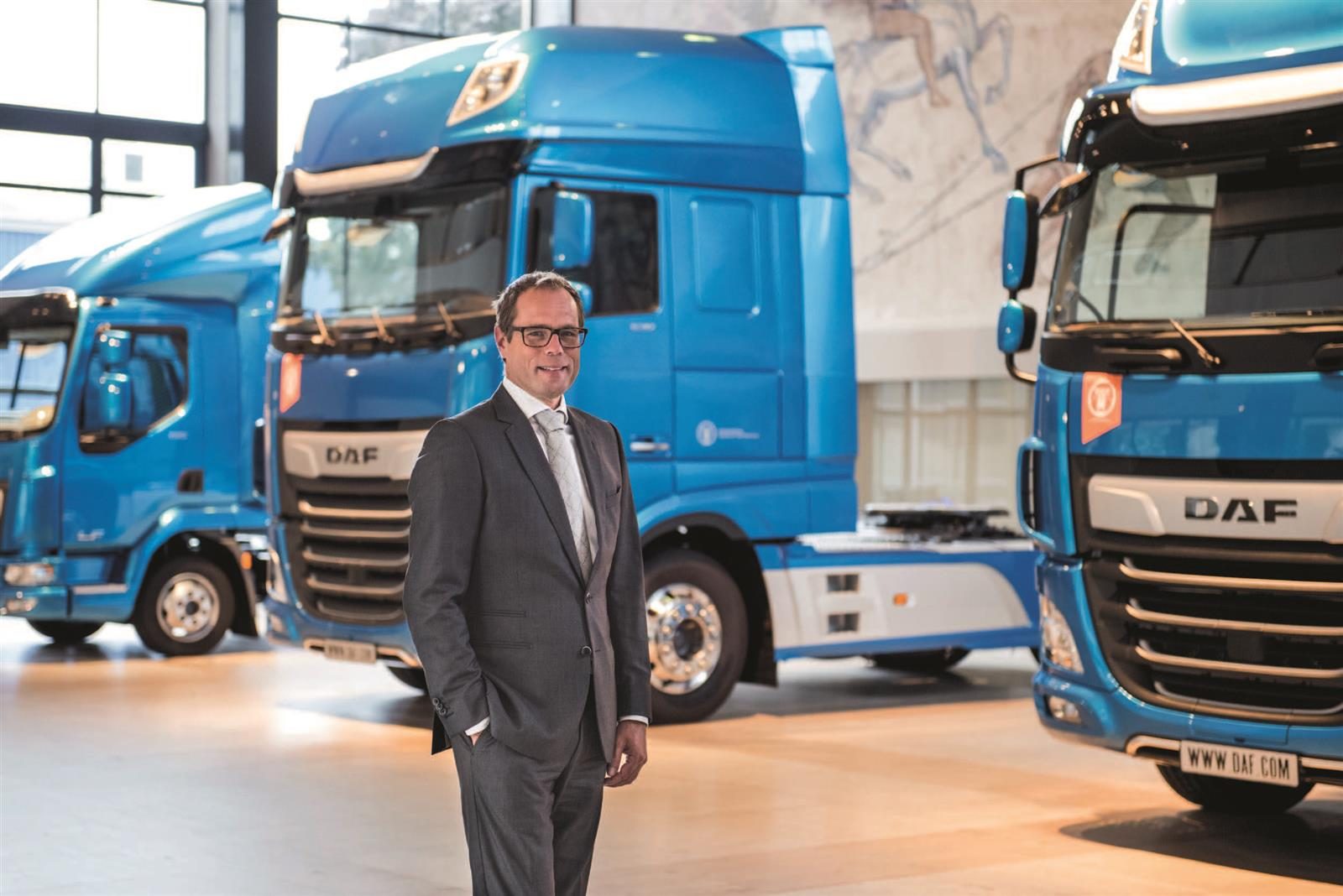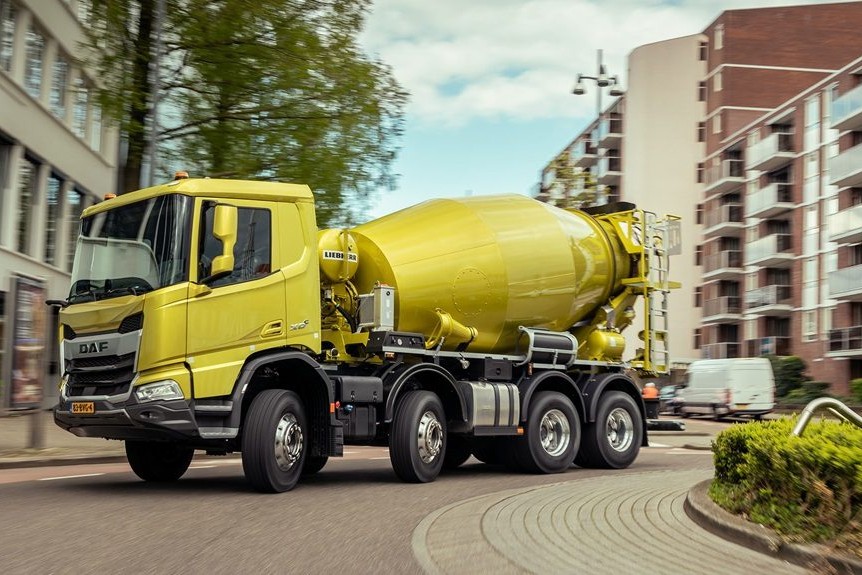PERSON OF INTEREST – Harry Wolters, president of DAF Trucks
“We are customer-focused”
It‘s often difficult to get a feel of where things are at in the top offices of the world‘s leading OEMs – often scattered around far-flung corners of the globe. However, president of the International Truck of the Year Jury, Gianenrica Griffini, recently met with DAF‘s newly appointed top man.

Photo: Harry Wolters, president of DAF: young, enthusiastic, inclusive, and ambitious.
Having celebrated its milestone 90th birthday last year, DAF continues to achieve record after record. Following an outstanding 2018, the Eindhoven-based company is determined to capitalise on the success it has achieved so far, and will do so with a new captain at the helm – Harry Wolters (48). Wolters actually began his career with the company some 23 years ago as a trainee. When you enter the office occupied by DAF‘s newly appointed president, you are immediately struck by the atmosphere. The impressively solid desk once belonged to DAF founder Hub van Doorne, and on the table is a highly polished bowl that was presented to the company by the DAF agents in 1953 to mark the company‘s 25-year anniversary. The antique grandfather clock has borne witness to numerous important management decisions. The whole space has a formal, stately quality that sits somewhat in stark contrast to the approach that Harry is known to favour: being easy to work with, friendly and approachable. “My door is always open, especially to good ideas that can help the company move forward.”
The European market leader for tractor units
Harry took up the role of president at DAF Trucks on 1 September 2018 and had the honour of reporting one of the strongest years in the company‘s history. With unit sales of almost 320,000 vehicles during 2018, the European market for heavy-duty trucks all but saw a return to the record levels of 2008 – and DAF reaped the benefits. European market share in the heavy-duty segment increased to a record 16.6%, making DAF the second-largest truck manufacturer on the continent. The company was also market leader in the important tractor unit segment and the number one import brand in Germany, as well as enjoying a sharp increase in popularity in the ‘international‘ markets. More than 8500 DAF trucks were sold in countries outside Europe during 2018 – a figure that is around 65% higher than that of three years earlier.
Harry M.B. Wolters
Employment History
| 2018 – now | President DAF Trucks |
| 2017 – 2018 | Director European sales Member of the Board of Management DAF Trucks |
| 2014 – 2017 | Director operations Member of the Board of Management DAF Trucks |
| 2013 – 2014 | Director human resources DAF Trucks |
| 2008 – 2013 | Manager truck assembly plant DAF Trucks |
| 2005 – 2008 | Manager logistics operations DAF Trucks |
| 2002 – 2005 | Manager logistics innovation DAF Trucks |
| 1999 – 2001 | Controller truck assembly plant DAF Trucks |
| 1997 – 1999 | Business engineer DAF Trucks |
| 1996 – 1997 | Management trainee DAF Trucks |
| Education | Technical University Eindhoven Masters Degree in Business Engineering |
The extra mile
“The secret to our success? Our excellent trucks,” says Harry. “Our customers really appreciate what the new CF and XF vehicles have to offer: the reliability, the favourable fuel consumption and the comfort – the latter being important given that transport operators are currently experiencing a squeeze on profits driven by a shortage of drivers. “However, it‘s important to remember that the trucks are only one cog in the machine. Any leading truck manufacturer must have all elements of its business in order: perfect parts supply, a wide range of financial services, repair and maintenance contracts and easy access to data via a first-rate fleet management system like DAF Connect. We must look at the entire picture, and it goes without saying that this includes an excellent dealer network. At DAF, we have made a conscious decision to work with a network of independent partners. Our dealers are entrepreneurs who are prepared to go the extra mile for the customer.”
Growth in rigids
A record market share, record production figures – what more could one ask for? “The fact that DAF is doing well does not mean that we can rest on our laurels,” Harry continues. “Quite the opposite, in fact. It‘s also true that there are segments that have potential for further growth for us. With a market share of almost 20%, we are leading the field in the European tractor unit segment. “We need to shout it even louder that DAF is always able to provide the perfect solution for rigids and for special applications as well. Two, three or four-axle vehicles, single or double drive, leading axles, trailing axles, steered and nonsteered axles – DAF can do it all. So yes, we are keen to grow our rigids business. If you consider that almost 70% of all trucks sold in the construction industry are rigids, it‘s not hard to see why this is a focus area for us.”
Added value
DAF has not always been known as a technical innovator. For as long as anyone can remember, the Dutch truck manufacturer has believed that new technologies should only be introduced if they have been fully developed and offer added value for the customer. “Our focus is completely on the customer. We have a very pragmatic approach,” says Harry. This strategy has certainly not done the company any harm. Perhaps surprisingly, DAF is among the front-runners when it comes to electric and hybrid vehicles. Initial testing of these vehicles is already underway with some of the company‘s leading customers. “Reducing CO2 emissions and improving air quality in urban areas are shared challenges,” he says. “As a truck manufacturer, we certainly have a part to play. Let‘s not forget, either, that the European Commission has tasked the truck industry with achieving a reduction in CO2 emissions of 15% by 2025 and a reduction of some 30% by 2030. When this sort of requirement is factored in, it‘s clear that we will definitely need to make use of all of the available technologies.”

Photo: The new XF and CF range are winners for the Eindhovenbased OEM.
Even greater proximity to the customer
Considerable time and resources are being invested in Eindhoven to ensure that DAF is ready to respond when the market shifts towards alternative drivelines. The company is also continuing its usual investments in the traditional diesel engine, as the advent of new fuels such as HVO (Hydrogenated Vegetable Oil) and power-to-liquid e-fuels heralds a bright future for the diesel engine (ref sidebar). “We must also remember to factor in the importance of developments in digitisation and what we call servitisation,” stresses Harry. “Big data will bring us ever closer to our customers, allowing us to improve our service offering. Providing an online fleet management system, in the form of DAF Connect, is just one example. Using the data generated by this system, we can proactively plan maintenance, proactively ensure that parts are available at the dealership when needed, provide even better advice in relation to future vehicle specifications, and customise training for drivers who could be operating their trucks even more efficiently. The possibilities and opportunities are endless.”
Proud to be part of PACCAR
The real question is whether or not DAF has the scale – i.e. whether or not DAF is a big enough company – to tackle the multitude of challenges facing the truck industry “Why wouldn‘t we?” Harry retorts. “We are proud to be part of PACCAR, which is the eighth-largest truck manufacturer in the world in terms of its production figures. If you look at how condensed the figures are between the fifth- and eighthplaced manufacturers, you could almost consider that we are the fifth-largest. The PACCAR Group has turned a profit eighty years in a row, which is a unique achievement within the industry. The company also continues to invest in all aspects of its operations, regardless of whether the economy is booming or experiencing a downturn.
“The synergy between the Kenworth, Peterbilt and DAF brands is a particularly important element of PACCAR‘s success. The brands collaborate on the development of stateof- the-art technologies such as autonomous driving. While operators are unlikely to find Kenworth and Peterbilt trucks on European roads, or DAF trucks being used in North America, they can be certain that the same technology is there beneath the skin. Half of all Peterbilt and Kenworth trucks use a powerplant developed in Eindhoven and, of course, DAF is looking on with interest as Kenworth takes important steps forward in relation to hydrogen-drive technology.” While DAF is among the most successful truck manufacturers in Europe, it also has global ambitions; for instance, in South America and South-East Asia. The Eindhoven-based truck manufacturer does not currently have China or India in its sights, although Harry explains that “we are certainly represented as part of the PACCAR Group”. “We do business with a host of suppliers in both of these countries via offices in Shanghai, Beijing and Pune, where we also have technology centres. We sell a lot of engines in China, to manufacturers of buses and coaches. As things stand, however, we do not think that now is the time to move into the truck segment. We have to be honest with ourselves – there is a very, very limited market for European trucks, not least for pricing reasons. We are keeping a very close eye on developments. As you can see, we are pragmatic in this respect as well.”
Powerful possibilities for internal combustion: the e-fuel
In addition to diesel – the good old-fashioned variety as well as biodiesels including HVO – and alternative fuels the likes of liquified natural and petroleum gas (which DAF considers to be only an interim solution), the Dutch manufacturer is looking into how another fuel option could be used to power its internal combustion engines. Advanced internal combustion engines, that is… Advanced engines need advanced fuels; ‘e-fuels‘ in this case. These are synthetic fuels that, according to Eurofuel.eu, “can be CO2 neutral and are a serious option to reduce greenhouse gas emissions while keeping the liquid form, which facilitates transport and storage of energy”. This is a huge boon compared with some other gaseous or liquid fuels that are not as energy dense as diesel (or petroleum, for that matter). E-fuels can either be mixed with traditional fuels or further processed into products with the same properties as gasoline, diesel, heating oil, or kerosene. So, how does one produce an e-fuel? It‘s a concept called ‘power-to-liquid‘ (PtL) that is based on the Fischer- Tropsch synthesis process. This is a set of chemical reactions that converts a mixture of carbon monoxide and hydrogen gases into synthetic liquid hydrocarbons (such as gasoline or kerosene). The Fischer-Tropsch process is used by several fuel companies around the world.
That doesn‘t mean the end of the road for the likes of biofuels, though. A combination of PtL and Biomassto- Liquid (BtL) technologies leads to the Power-and- Biomass-to-Liquid (PBtL) process. “In this case, the carbon dioxide is provided by the processing of biomass, while the hydrogen comes from the electrolysis of renewable electricity. The product generated is similar to PtL,” according to Eurofuel.eu.





